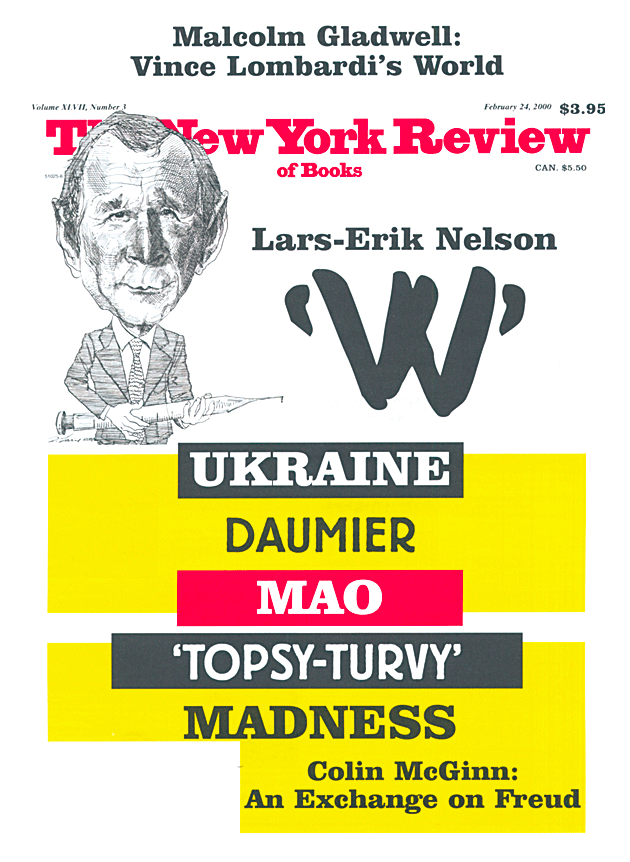To the Editors:
I wish to comment on the exchange between Kenneth Wolf and Charles Rosen [NYR, December 16, 1999]. I am surprised that Mr. Rosen’s reply did not acknowledge the importance of the transient at the beginning of a note. I believe this is well documented. Nevertheless, Mr. Rosen is correct that the piano player, in contrast to a wind or string player, can do nothing to affect this transient. In particular, the “acceleration” referred to by Professor Wolf has ceased before the hammer strikes the string. According to Michael Mohr of Steinway and Sons: “During the last 1/16 inch of its motion, the hammer is traveling entirely on its own momentum.”1 The hammer therefore has no acceleration except for the weak effect of gravity when it hits the string.
David W. Ross
Austin, Texas
To the Editors:
As a student of the technology and history of the piano, I must thank Charles Rosen for his staunch defense of what is indubitably true—that the tone of the modern piano cannot be physically affected by the pianist.
As I read the exchange of letters in the current issue of The New York Review of Books, I tried to think how the myth of the singing tone could have arisen. I suspect it comes from confusing the different characteristics of the two types of piano action predominant in the late nineteenth century, the Viennese escapement and the eventually victorious double escapement.
The double escapement action was developed to accommodate the need to quickly repeat a given note, which was an essential aspect of Liszt’s technique. What was sacrificed was the ability that the Viennese action had to alter the striking point of the hammer on the string and consequently the ability of the pianist to affect the tone of the vibrating string.
When I worked as a technician at Klavierhaus Mannheim in Salzburg, my favorite among our rental instruments was a pre-World War I Bösendorfer with a Viennese action. It was my baby and I was very pleased when it was chosen for a “Polen Hilfe” concert in 1981 and was given good reviews.
How many of us play Liszt at home? From the vehemence of Mr. Rosen’s attackers it is clear that the desire of pianists to be able to affect the tone of the piano is very strong. Perhaps the time has come to resurrect the nineteenth-century Viennese piano.
Carolyn Kunin
Pasadena, California
P.S. I cannot, however, agree with Mr. Rosen about key-massaging. The first time I saw a pianist do this after I had begun my training at the New England School of Stringed Keyboard Instrument Technology was in Boston in 1979 or 1980. Caught off guard, I inadvertantly let a giggle escape, and was surprised when a gentleman in the row ahead turned around and gave me an appreciative wink. I was later informed that that gentleman was Murray Perahia.
Charles Rosen replies:
What excited controversy following my article was my claim that there was no mechanical way of pushing down the piano keys which could be learned so as to produce a beautiful sound, but that a beautiful tone quality depends solely on gradations of volume which shape the melody and gradations within the chords, so that the harmony is vibrant (exploiting the overtones and also allowing the melody to be slightly in relief), as well as the use of the pedal. There were many letters, some sent to the NYR and some sent directly to me. One correspondent even wrote: “That such a claim is false is the least of it. For those of us from Curtis and Juilliard, it is scandalous almost beyond words.”
I have never denied the existence of the slight percussive noise that accompanies the initial impact of every piano note: all I said was that one cannot change the quality of sound by the way the note is played—one can only play softer and louder, longer and shorter. In spite of the beliefs of many piano teachers, the beauty of sound depends on purely musical considerations—shaping the melodic line, balancing the harmony—not on whether the notes are played gracefully or with a relaxed arm and body.
Since those who, unlike me, truly understand the technical aspect of piano construction have written to say that I am correct about modern pianos (it is not exactly clear to me, by the way, how the old “Viennese” single escapement action enabled one to alter the sound quality even minimally), it might be interesting to study the origin of the delusion that a purely physical action can change the quality of sound of a piano. It is true that a gentle movement of the wrist and a relaxed arm can influence an interpretation heuristically, give greater control of the muscles, enable us to balance the sounds, and help us to avoid indiscriminate thumping. There is something to be said for the standard teaching methods when they are successful even if mistaken; but I think they would be even more effective if they concentrated on the musical values which actually determine what we normally consider a beautiful sound.
This Issue
February 24, 2000
-
*
Scientific American, January 1999, pp. 118-119. ↩


